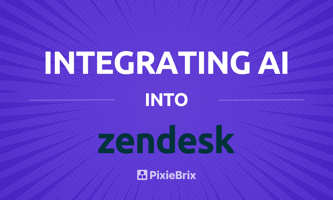This post discusses four ways that PixieBrix can multiply the ROI of your UiPath deployment.
The Death of Swivel-Chair Integration
In 1973 Larry Tesler invented the concepts of "cut," "copy" and "paste" at Xerox’s Palo Alto Research Center (PARC). As digital record keeping gained enterprise adoption, Ctrl+C and Ctrl+V soared in popularity, especially among data entry and processing professionals. Today, they’re the most common keyboard shortcuts.
So what does this have to do with swivel-chair integration? And how can you kill this process once and for all?
What is swivel-chair integration?
While Ctrl+C and Ctrl+V are perfect shortcuts for ad hoc data transfer, they’re inefficient for routine or recurring workflows. Over-reliance on these shortcuts — and similar processes — have led to what’s called “swivel-chair integration.” This term describes any integration that requires a human to actively switch between tools, meaning it’s not much of an integration at all.
For example, here’s a real excerpt from new agent training at Acme Insurance Company:
Repeat after me: Ctrl+C, switch tab, Ctrl+V. Ctrl+C, switch tab, Ctrl+V. Repeat until you’ve populated each data field in web portal A from database B. Be sure to always reformat items X, Y, and Z or the application won’t pass QA, which bogs you down in reprocessing. Expert tip: most newbies underestimate the inefficiency caused by rework, which is why they tend to miss quota. Trust me I’ve been in your chair - get it right the first time. Oh, and if conditions 1 or 2 are met, data fields 3 and 4 are likely outdated, in which case assume 5 and 6. Ready to start processing?
Okay, the above is a bit of a joke, but the true complexity of the issue is no joke. Companies in every industry face difficult challenges related to integrating an ever growing set of applications, and extending these tools to fit the exact needs of their business (or settling when they don’t). Native integrations fall short, and while API integration platforms solve some of the issues, they’re configurable, not customizable. You still get only what they give you.
Okay, while that’s a bit of a joke, swivel-chair integration isn’t. Companies across industries face growing tool stacks that need to be integrated and extended to fit the exact needs of their business. When that’s not possible, they have to settle for sub-standard processes.
So what are your options? Native integrations fall short. API integration platforms solve some of these issues, but they’re not customizable to your needs. You get what they give you.
The real solution to swivel-chair integration requires combining two technologies which create the opportunity for hyper-automation:
- Traditional API Integration Platforms
- Robotic process automation and process mining
The 2 technologies you need to kill swivel-chair integration
Traditional API Integration Platforms
Traditional API integration platforms offer third-party connectors for exchanging common data among a company’s applications. They provide a finite number of premade flows and typically serve the largest SaaS vendors in each category. A key benefit is the as a service aspect which requires no DevOps or overhead. The downside is flows are configurable not customizable, and they’re focused on standardization and volume over intelligence or human interaction.
Examples of these platforms include:
- Celigo
- Tray.io
- Flowgear
- IBM Cloud Integration
- Mulesoft
Robotic process automation and process mining
Robotic process automation (RPA) uses configurable bots to emulate the actions of a human interacting with computer programs. It’s most widely used today for automating repetitive, rules-based business processes. Additionally, process mining is an approach for improving processes by extracting data from event logs to uncover inefficiencies and waste.
Examples of tools for this include:
- Automation Anywhere
- Blue Prism
- UiPath
- Pega
- Kryon
- Linx
So how can you combine these technologies in one package?
PixieBrix
PixieBrix is a low-code platform you can use to build browser enhancements, automate repetitive actions, and get more out of your tools. With premade mods from the PixieBrix marketplace, you can even do this without any coding knowledge at all.
With PixieBrix, anyone with a working knowledge of config files can quickly build browser-based integrations and automate processes that span multiple applications and databases. Whether you’re Acme Insurance Company, underwriting thousands of applications daily, or just need to get a handle on your tool stack, PixieBrix is the right integration solution for you.
Here are just a few examples of pre-built PixieBrix integrations you can use right now:
- Create new Jira issues from selected text
- View your Automation Anywhere Control Room from any website
- Automatically push data to Airtable
- Search HubSpot data through a sidebar in your browser
- Push data to Zapier automatically
Ready to kill your swivel-chair integrations? Sign up for PixieBrix and start integrating your tools for free.


